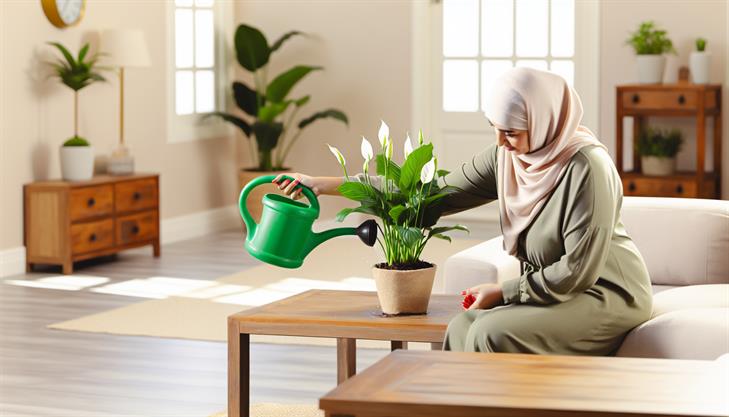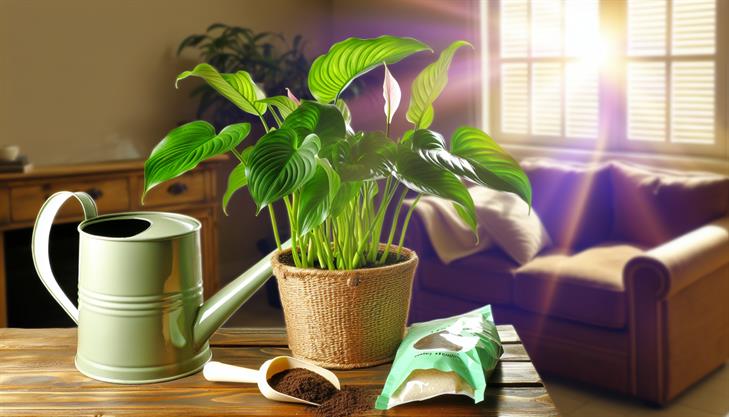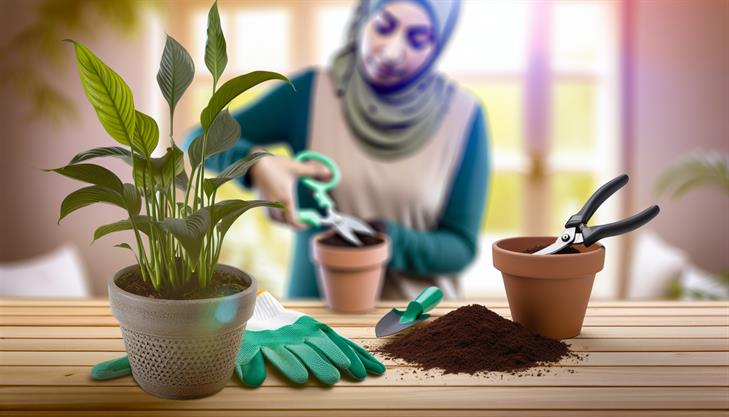The Peace Lily, with its lush green leaves and elegant white blossoms, is more than just a beautiful addition to any room—it’s a living purifier that breathes life and tranquility into your home. As one of the most popular houseplants, the Peace Lily is not only loved for its aesthetic appeal but also revered for its remarkable ability to cleanse the air of toxins, making it a must-have for any household. However, to truly let this graceful plant thrive and continue enhancing your indoor environment, it requires a touch of care and attention. In our definitive guide on ‘How to Care for a Peace Lily Houseplant,’ we delve into everything you need to know to nurture your green companion. From understanding its watering needs and addressing common issues to optimizing its growth environment, this guide offers expert tips that turn plant care from a chore into a delightful part of your day. Whether you’re a seasoned plant parent or a budding enthusiast, this post is your go-to resource for unlocking the full potential of your Peace Lily. Ready to refine your green thumb and transform your space? Let’s dive in and discover how simple it is to keep your Peace Lily flourishing.
Understanding the Basics of Peace Lily Care
Taking care of a peace lily houseplant requires understanding its specific needs and creating an environment that closely mimics its natural habitat. With the right conditions, a peace lily can thrive and enhance your indoor space with its lush green leaves and elegant white blooms. Here’s a comprehensive guide on how to care for a peace lily houseplant:
Optimal Light Conditions
Peace lilies prefer medium to low light conditions, making them ideal for indoor environments. They flourish best when placed in bright, indirect light; direct sunlight can scorch their leaves, causing them to turn yellow. If your peace lily is not flowering, consider moving it to a brighter spot, but be mindful of direct sun exposure.
Proper Watering Techniques
Proper watering is crucial for peace lily care. They like to be kept moist but not soggy. Allow the top inch of soil to dry out between waterings. During warmer months, you may need to water more frequently. A good tip is to wait until the leaves begin to droop slightly before watering, indicating the plant’s need for moisture. Ensure your peace lily pot has drainage holes to prevent waterlogging, which can lead to root rot.
Humidity and Temperature
Peace lilies thrive in high humidity environments, similar to their natural tropical habitat. Increase humidity around your plant by misting it regularly, placing it near a humidifier, or setting the pot on a pebble tray filled with water. Ideal temperatures for peace lilies range from 65°F to 80°F (18°C to 27°C). Avoid placing them near air vents or drafts, as sudden temperature changes can stress the plant.
Soil and Fertilizing
A well-draining potting mix is essential for a peace lily. A standard houseplant or all-purpose potting soil amended with perlite or sand ensures adequate drainage. Feed your peace lily every 6-8 weeks during the growing season (spring and summer) with a balanced, water-soluble fertilizer. Reduce feeding in the fall and winter when the plant’s growth slows.
Common Issues and Troubleshooting
Peace lilies can be susceptible to a few common issues. Brown leaf tips often indicate a need for increased humidity or proper watering. Yellow leaves can signal overwatering or excessive sunlight exposure. If your peace lily is not flowering, it might not be receiving enough light, or it lacks nutrients. Regularly dust the leaves with a damp cloth to prevent pests like spider mites from taking hold.
Additional Tips
- Repotting: Peace lilies prefer a slightly tight pot but can be repotted every couple of years in spring to refresh the soil and encourage growth.
- Cleaning Leaves: Wipe the leaves occasionally to remove dust and improve photosynthesis, which keeps the plant healthy.
- Pet Safety: If you have pets, be cautious as peace lilies are mildly toxic if ingested. Position them out of reach to avoid any potential issues.
By following these comprehensive care instructions, your peace lily houseplant can prosper, adding a touch of elegance and tranquility to your home. With the right attention to light, water, and environment, you’ll enjoy this beautiful plant for years to come.
Essential Tips for Watering and Feeding Your Peace Lily
Peace lilies are popular houseplants known for their lush green leaves and elegant white blooms. Proper care for a peace lily involves understanding its watering and feeding needs, which are crucial for maintaining its health and beauty. Here’s a comprehensive guide on how to care for a peace lily houseplant, ensuring it thrives year-round.
Understanding the Watering Needs
-
Check Soil Moisture Regularly: Peace lilies prefer consistently moist soil, but they don’t like sitting in water. Check the soil moisture weekly by inserting your finger about an inch into the soil. If it feels dry, it’s time to water.
-
Watering Technique: Use room-temperature water to avoid shocking the plant’s roots. Thoroughly water the plant until excess moisture drains from the bottom of the pot. This ensures that all roots have access to moisture.
-
Frequency: Typically, watering once a week is sufficient. Increase watering frequency during the warmer months or if the indoor air is particularly dry. In cooler months, the plant’s water needs decrease.
-
Signs of Overwatering or Underwatering: Yellow leaves often indicate overwatering, while drooping leaves may signal either overwatering or underwatering. Adjust your watering routine if these signs appear.
Feeding Your Peace Lily
-
Choose the Right Fertilizer: Use a balanced, water-soluble houseplant fertilizer to nourish your peace lily. Look for a formula with equal ratios of nitrogen, phosphorus, and potassium.
-
Feeding Schedule: Feed your peace lily every 6 to 8 weeks during the growing season, typically from spring through summer. Reduce feeding in the fall and winter when the plant’s growth slows.
-
Application Method: Dilute the fertilizer to half the recommended strength to avoid over-fertilization, which can damage the plant. Apply during a regular watering session to ensure even distribution and prevent root burn.
Common Issues and Additional Tips
-
Proper Light Conditions: Peace lilies thrive in low to moderate light but prefer indirect sunlight. Too much direct sun can scorch the leaves, while too little can hinder blooming.
-
Humidity: Peace lilies enjoy higher humidity levels. If your home is particularly dry, consider placing the plant on a tray filled with pebbles and water or use a humidifier to maintain appropriate humidity.
-
Pot Considerations: Ensure your peace lily is planted in a well-draining potting mix, and the container has adequate drainage holes. This prevents waterlogging, which can lead to root rot.
-
Pruning and Maintenance: Regularly remove any dead or yellowing leaves to encourage healthy growth. Trim spent blooms to tidy the plant and promote new flower production.
By following these essential tips for watering and feeding, you can ensure your peace lily remains a vibrant and flourishing part of your indoor garden. Remember, a little attention and the right care can make all the difference in your plant’s health.
Achieving Optimal Light and Temperature Settings for Your Peace Lily
Caring for a peace lily houseplant involves creating an environment where the plant can thrive by focusing on optimal light and temperature conditions. Peace lilies are known for their elegant white blooms and lush foliage, which make them a popular choice among indoor plant enthusiasts. Here’s how you can ensure your peace lily remains healthy and vibrant:
1. Light Requirements:
Peace lilies prefer bright, indirect light. They are well-suited for north or west-facing windows, where sunlight is filtered rather than direct. Direct sunlight can scorch the leaves, leading to browning edges.
- Placement Tip: If natural light is limited, you can use fluorescent lights to supplement. Position the peace lily about 6 to 12 inches under the light source for about 12-14 hours per day.
- Common Issue: If your peace lily isn’t blooming, it may not be getting enough light. Adjust its position for more light exposure, but ensure it remains indirect.
2. Temperature Settings:
Peace lilies thrive in warm, stable temperatures. They prefer a temperature range of 65-80°F (18-27°C).
- Avoid: Cold drafts or sudden temperature changes can stress the plant. Keep your peace lily away from windows or doors that open to the outside during winter.
- Seasonal Care: During colder months, ensure your plant is situated away from heaters or radiators as excessive heat can dry it out.
3. Watering Practices:
Watering correctly is crucial for the health of your peace lily. Overwatering is a common mistake that leads to root rot, while underwatering can cause the plant to wilt.
- Watering Tips: Allow the top inch of soil to dry out before watering again. Typically, this may mean watering once a week, but it can vary based on your home’s humidity and temperature.
- Symptom Check: If the leaves droop, it’s usually a sign they need water. Conversely, yellowing leaves may indicate overwatering.
4. Humidity Needs:
Being tropical plants, peace lilies prefer high humidity levels.
- Boost Humidity: You can increase humidity by misting the plant with water, placing a humidifier nearby, or placing the pot on a tray filled with pebbles and water. Ensure the bottom of the pot is not in direct contact with the water to prevent root rot.
- Additional Advice: Grouping plants together can also help increase the local humidity level.
5. Soil and Feeding:
A well-draining potting mix is ideal for peace lilies. You can use a peat-based mixture to ensure good drainage while retaining some moisture.
- Fertilization: Feed your peace lily with a balanced, water-soluble houseplant fertilizer every 6 to 8 weeks during the growing season (spring and summer). Reduce feeding during fall and winter when growth typically slows.
- Troubleshooting: If you notice white crust on the soil surface, it might be salt build-up from fertilizers. Flush the soil with water or repot with a fresh mix.
6. Pruning and Pest Management:
Regular pruning keeps the plant healthy and encourages new growth. Remove any yellow or brown leaves by cutting them at the base with clean scissors.
- Watch for Pests: Peace lilies can occasionally attract pests like aphids or spider mites. Treat affected plants with insecticidal soap or neem oil, following package instructions.
By following these steps and keeping an eye on your plant’s overall condition, you can enjoy a flourishing peace lily that enhances the beauty of your home. Remember that each peace lily may have unique needs based on its specific environment, so adjusting your care routine may be necessary over time.
Pruning and Repotting: Keeping Your Peace Lily Healthy
Caring for a peace lily houseplant involves a few key practices that, when done correctly, ensure your plant stays healthy and vibrant. Peace lilies, known for their lush green leaves and stunning white blooms, are resilient plants, making them ideal for both novice and experienced indoor gardeners. Below, we provide a step-by-step guide on how to care for a peace lily houseplant, along with some tips on pruning and repotting.
1. Choosing the Right Location:
Peace lilies thrive in a variety of light conditions but prefer indirect sunlight. Place your plant near a north or east-facing window where it can get plenty of natural light without direct exposure, which can scorch the leaves.
2. Watering Your Peace Lily:
Peace lilies are sensitive to both overwatering and underwatering. Allow the top inch of soil to dry out before watering. Insert your finger into the soil; if it feels dry, it’s time to water. Use room temperature water and ensure that excess water drains out of the pot to prevent root rot.
3. Humidity and Temperature:
These tropical plants appreciate a bit of humidity. If your home is dry, consider misting the leaves once a week or placing the pot on a tray filled with pebbles and water to increase humidity. Peace lilies prefer temperatures between 65-85°F (18-29°C) and should be kept away from cold drafts or sudden temperature changes.
4. Fertilizing Peace Lilies:
Feed your peace lily with a balanced liquid houseplant fertilizer every 6-8 weeks during the growing season (spring and summer). Avoid over-fertilizing, as this can lead to brown leaf tips.
5. Pruning for Health:
Regular pruning helps maintain your peace lily’s shape and promotes healthy growth. Remove any yellow or brown leaves by cutting them at the base with a pair of sharp, clean scissors. Dead flowers should also be pruned to encourage new blooms.
6. Repotting Your Peace Lily:
Repotting is crucial when your peace lily has outgrown its container or if the soil becomes compacted. Typically, you’ll need to repot every 1-2 years. Choose a pot that is one size larger and ensure it has drainage holes. Use a well-draining, all-purpose potting mix. When repotting, carefully remove the lily from its current pot, gently separate any crowded roots, and place it into the new container, filling in with fresh soil.
7. Common Issues and Troubleshooting:
- Brown Leaf Tips: Often caused by low humidity or over-fertilization. Increase humidity and check your fertilizing routine.
- Yellow Leaves: This can indicate overwatering or insufficient light. Adjust watering habits or relocate your plant to a brighter location.
- No Blooms: If your peace lily isn’t flowering, it may need more light or a dose of fertilizer.
By following these care tips and steps, your peace lily houseplant can remain a healthy and beautiful part of your indoor garden for years to come. Remember, like all plants, peace lilies have their individual preferences, so it may take a bit of observation and adjustment to find the perfect care routine for yours.
Troubleshooting Common Peace Lily Problems and Solutions.
Peace lilies are popular indoor plants known for their beautiful white flowers and lush green leaves. Proper care is essential to keep your peace lily healthy and thriving. Below are detailed instructions on how to care for a peace lily houseplant, along with solutions to common problems you may encounter.
Light Requirements
Peace lilies prefer indirect, moderate light. Direct sunlight can scorch their leaves, while too little light might prevent them from blooming. An ideal spot is a few feet away from a north or east-facing window. If your plant starts looking droopy or yellow, adjust its lighting conditions gradually to prevent shock.
Watering
Consistent and proper watering is crucial. Peace lilies enjoy moist but not soggy soil. Water when the top inch of soil feels dry to the touch. Overwatering can lead to root rot, often signaled by yellowing leaves. Use distilled or rainwater if possible, as tap water’s chemicals can harm the plant over time.
Humidity and Temperature
These plants thrive in high humidity environments. To boost humidity:
- Mist the leaves with water regularly.
- Place a humidifier nearby.
- Set the pot on a tray filled with pebbles and water, ensuring the pot isn’t submerged.
Maintain temperatures between 65°F and 85°F. Avoid exposing the plant to cold drafts or temperatures below 55°F, which can hinder its growth.
Fertilization
Peace lilies do not require heavy fertilization. Feed your plant with a balanced, water-soluble houseplant fertilizer every 6-8 weeks during the growing season (spring and summer). Avoid over-fertilizing, which could cause leaf tips to brown.
Soil and Potting
Choose a well-draining soil mix, such as a high-quality potting soil enhanced with perlite for aeration. If your peace lily becomes root-bound or outgrows its pot, repot it in a container that is slightly larger in size, ensuring that you refresh its soil.
Pruning and Maintenance
Trim away yellowing or dry leaves as necessary to maintain the plant’s appearance. Clean leaves with a damp cloth to remove dust, which can affect photosynthesis. Watch for pests like spider mites or aphids; treat infestations with gentle insecticidal soap if they arise.
Common Issues and Solutions
-
Wilting Leaves: Often due to underwatering. Check soil moisture, and adjust your watering schedule. If overwatered, allow the soil to dry out a bit more.
-
Brown Leaf Tips: Could be caused by over-fertilization or fluoride in tap water. Flush the soil with clean water and use distilled water moving forward.
-
No Blooms: Lack of blooming may result from insufficient light or too much fertilizer. Ensure the plant has adequate access to indirect light and adjust fertilization as needed.
By consistently monitoring your peace lily’s light, water, and soil conditions, and by following these care instructions, you’ll help ensure that your peace lily remains healthy and vibrant throughout the year.
In conclusion, caring for a peace lily houseplant can be a rewarding experience that adds both beauty and tranquility to your home. By ensuring your peace lily receives the right amount of indirect sunlight and watering only when the soil feels dry, you can maintain its lush foliage and stunning white blooms. Remember to keep the leaves clean from dust, provide monthly feeding with a balanced fertilizer, and periodically repot to accommodate its growing needs. By understanding and responding to the peace lily’s subtle signals, such as drooping leaves or brown tips, you can address issues swiftly and keep your plant healthy.
Apply what you’ve learned, and watch your peace lily flourish, transforming your living space into a serene haven. Finally, to truly enhance your peace lily care routine, consider grouping your plant with others to boost humidity levels naturally, promoting even healthier growth. Happy gardening!


